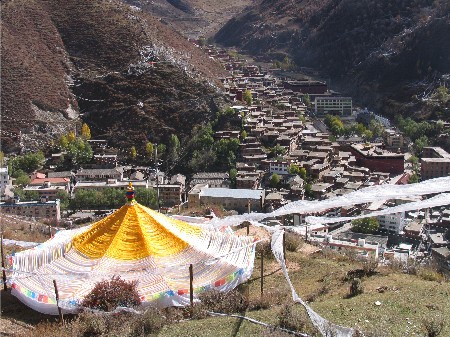Dergé: Difference between revisions
Jump to navigation
Jump to search
No edit summary |
No edit summary |
||
| Line 7: | Line 7: | ||
==Further Reading== | ==Further Reading== | ||
*Josef Kolmaś, ''Genealogy of the Kings of Derge: Sde-dge'i Rgyal-rabs'', Prague: Academia, 1968 | *Josef Kolmaś, ''Genealogy of the Kings of Derge: Sde-dge'i Rgyal-rabs'', Prague: Academia, 1968 | ||
*Josef Kolmaś, 'Dezhung Rinpoche's Summary and Continuation of the Sde-dge'i Rgyal-rabs' in ''Acta Orientalia Hungarica'', vol. 42 no. 1 (1988) 119-152. | |||
*Leonard van der Kuijp, 'Two Early Sources for the History of the House of Sde-dge' in ''Journal of the Tibet Society'', vol. 8, 1988, pp. 1-20 | *Leonard van der Kuijp, 'Two Early Sources for the History of the House of Sde-dge' in ''Journal of the Tibet Society'', vol. 8, 1988, pp. 1-20 | ||
Revision as of 18:56, 27 June 2009

Dergé (Wyl. sde dge) — a region and also a town situated in Eastern Tibet. It was the birthplace of Dilgo Khyentsé Rinpoche and Nyoshul Khen Rinpoche, and is also the location of a famous printing house.
Name
The name 'Dergé' is often glossed as the place of the four aspects of wellbeing (sde bzhi) and the ten virtues (dge ba bcu).
Further Reading
- Josef Kolmaś, Genealogy of the Kings of Derge: Sde-dge'i Rgyal-rabs, Prague: Academia, 1968
- Josef Kolmaś, 'Dezhung Rinpoche's Summary and Continuation of the Sde-dge'i Rgyal-rabs' in Acta Orientalia Hungarica, vol. 42 no. 1 (1988) 119-152.
- Leonard van der Kuijp, 'Two Early Sources for the History of the House of Sde-dge' in Journal of the Tibet Society, vol. 8, 1988, pp. 1-20